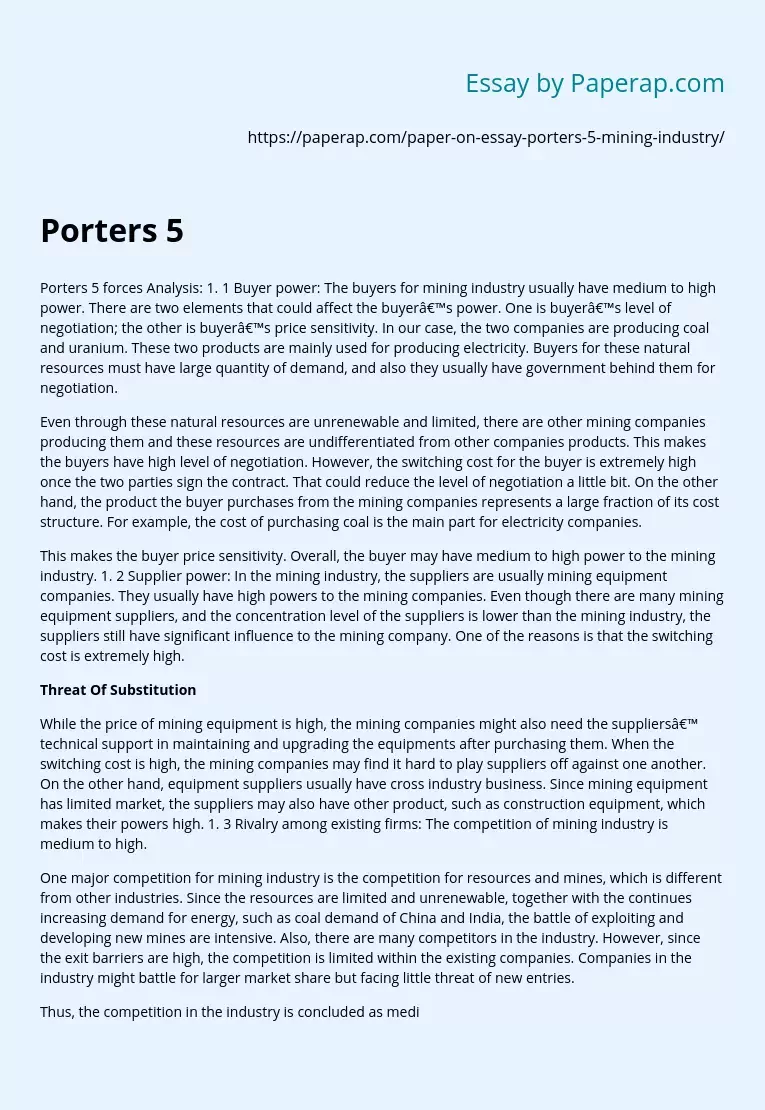Porters 5 Forces Analysis for Mining Industry
Porters 5 forces Analysis: 1. 1 Buyer power: The buyers for mining industry usually have medium to high power. There are two elements that could affect the buyer’s power. One is buyer’s level of negotiation; the other is buyer’s price sensitivity. In our case, the two companies are producing coal and uranium. These two products are mainly used for producing electricity. Buyers for these natural resources must have large quantity of demand, and also they usually have government behind them for negotiation.
Even through these natural resources are unrenewable and limited, there are other mining companies producing them and these resources are undifferentiated from other companies products. This makes the buyers have high level of negotiation. However, the switching cost for the buyer is extremely high once the two parties sign the contract. That could reduce the level of negotiation a little bit. On the other hand, the product the buyer purchases from the mining companies represents a large fraction of its cost structure.
For example, the cost of purchasing coal is the main part for electricity companies.
This makes the buyer price sensitivity. Overall, the buyer may have medium to high power to the mining industry. 1. 2 Supplier power: In the mining industry, the suppliers are usually mining equipment companies. They usually have high powers to the mining companies. Even though there are many mining equipment suppliers, and the concentration level of the suppliers is lower than the mining industry, the suppliers still have significant influence to the mining company. One of the reasons is that the switching cost is extremely high.
Threat Of Substitution
While the price of mining equipment is high, the mining companies might also need the suppliers’ technical support in maintaining and upgrading the equipments after purchasing them. When the switching cost is high, the mining companies may find it hard to play suppliers off against one another. On the other hand, equipment suppliers usually have cross industry business. Since mining equipment has limited market, the suppliers may also have other product, such as construction equipment, which makes their powers high. 1. 3 Rivalry among existing firms: The competition of mining industry is medium to high.
One major competition for mining industry is the competition for resources and mines, which is different from other industries. Since the resources are limited and unrenewable, together with the continues increasing demand for energy, such as coal demand of China and India, the battle of exploiting and developing new mines are intensive. Also, there are many competitors in the industry. However, since the exit barriers are high, the competition is limited within the existing companies. Companies in the industry might battle for larger market share but facing little threat of new entries.
Thus, the competition in the industry is concluded as medium to high. 1. 4 Threat of new entrants: New entrants may pose a threat to the company by introducing new innovative products at a competitive prices and eating into their market share and customer loyalty. The threat of entry for the coal and uranium industry tends to be low due to high entry barriers. The reason for this is the government regulations and restriction on coal and uranium mining companies. Resources of coal and uranium are laminated. The capital expenditure or set up of mining company is very high.
Moreover, mining companies has a high exit cost and that because the use of specialized asset. Also, the technique requirement of the industry is high. This results in low new entrants, which eventually will increase profitability for all firms in the industry. 1. 5 Availability of substitutes: Companies face risk from others that produce different products with similar functions. In case of uranium, the threat of substitution tends to be very low as the nuclear reactors in other countries wanting to cut their greenhouse gas emissions, that uranium has a bright future.
In case of coal, the availability of substitutes is low to medium. The reason of that are the sources to generate power are limited and costly which, it will cost the corporation very high amount of fixed cost if they decide to switch to another source. However, there are some substitutions such as crude oil; natural gas nuclear power can replace the coal in some way, but not every way because approximately 40% of the world electricity production uses coal.
Porters 5 Forces Analysis for Mining Industry. (2019, Dec 05). Retrieved from https://paperap.com/paper-on-essay-porters-5-mining-industry/

